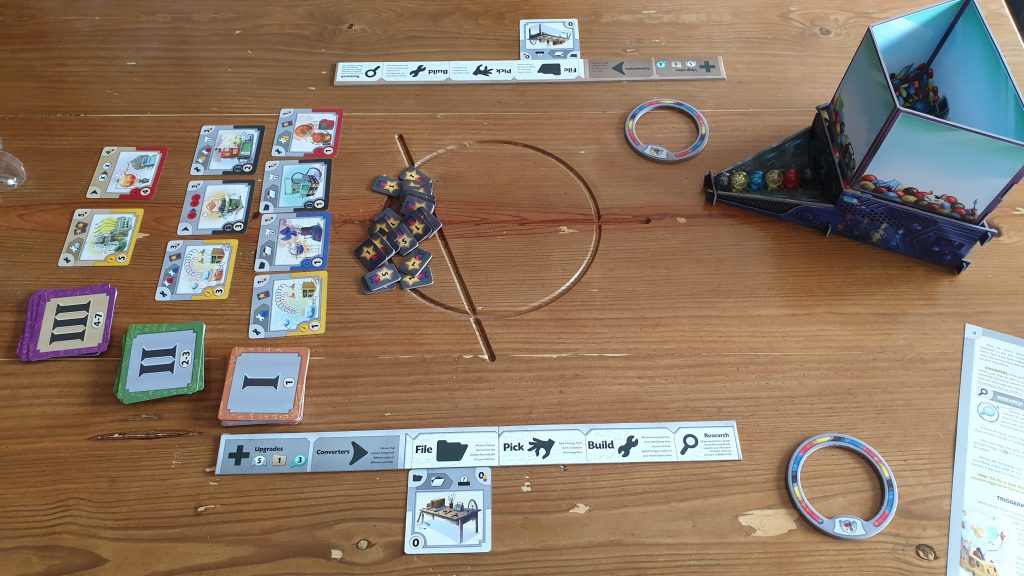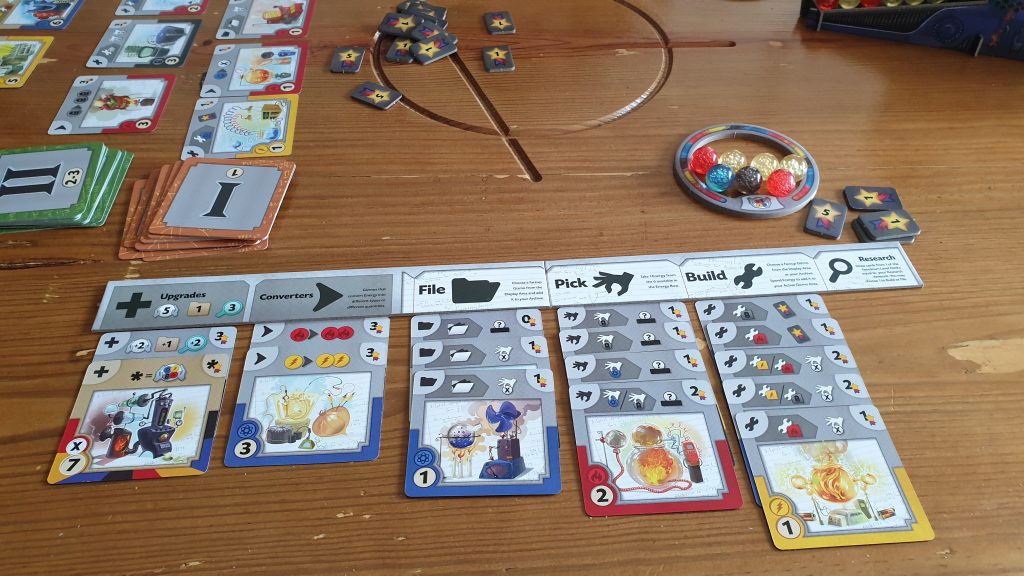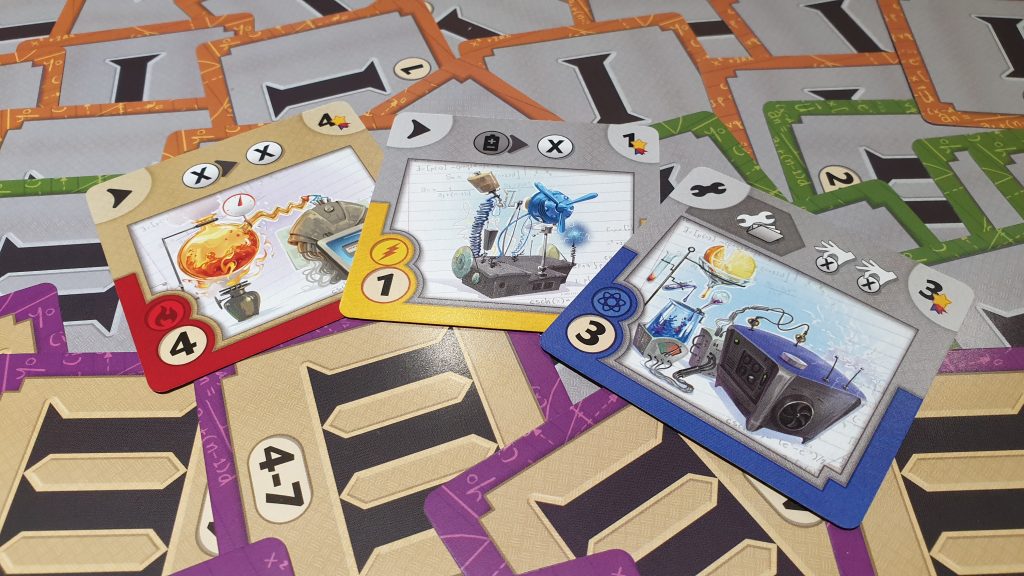Gizmos is the latest board game to be released from designer Phil Walker-Harding, the man behind Barenpark and Gingerbread House. Published by CMON, the game features tableau building and engine building mechanisms. Throughout the game 2 – 4 players will build vast machines at a science fair, use four different types of energy and aim to do things faster and better than anyone else. However, with the ability to change energy types, does this need to change to be good? Let’s find out!
Setup doesn’t take too long, being only a matter of minutes: with the mostly together dispenser being put into the center of the table, and marbles tipped in. Note that prior to your first game you will needed to have constructed it – though it stores in two parts in the box. Each player receives a board at random, one being a different colour to designate that player as the starting player. Everyone gets an identical starting File type gizmo card, a store of available gizmo cards is constructed and the game is ready to begin.
The aim of Gizmos is to obtain the most victory points, by purchasing gizmo cards and potentially earning bonus points from triggering specific gizmo actions that award them. At the start of the game each player is even, with the same 4 actions available and the same non-existent engine. Over the course of the game these actions will change for each player, being upgraded by building gizmos and triggering when specific actions are taken. The actions you can take are Pick, Build, Research and Folder.

The basic pick action is to simply choose one of the six marbles from the visible dispenser shoot and add it to your energy ring. File allows the player to save one card from the central store to be built later on. Build allows the player to spend energy from their energy ring to build a gizmo, which is placed into their tableau in the column the gizmo relates to action wise. When doing this the gizmo can either be one filed earlier or directly from the store. Finally, research allows you to draw the top three cards of one of the store decks and either build or file one card, discarding the other two.
This research action is the first hint at how these actions can trigger and interact with each other. For example, if you have built a gizmo that allows you to pick a marble whenever you File, taking the research action could see you File one of three cards. This would trigger the File ability to then pick a marble from the dispenser. Gizmos only trigger once but if you have multiple gizmos that trigger on the same action they are all performed. On top of this it is possible for triggered events to trigger further events, like a planned domino effect.
At the start of the game your energy ring can house 5 energy marbles, only 1 card can be filed for later and 3 cards are drawn during research. If an action takes you over these it cannot be done. Thankfully, if it is triggered effects that would cause this it is still possible, just ignore the triggered effects. After taking an action play continues clockwise around the table until one player reaches 16 constructed gizmos or 4 tier 3 gizmos. At this point the current round plays out and points are summed up. Whomever has the most points wins, with ties split by having the most gizmos built, then energy remaining.

The endpoint of Gizmos can be slightly anticlimactic, despite it being thematic from the stance of being fastest to build at a science fair. While it isn’t just as engines get going, a huge plus point, the 16 card limit feels incredibly artificial. To make matters worse there is no easy way other than constantly counting cards to work out how many cards both you and your opponents have built. Suddenly, when your plan is coming together, a player will realise and announce they are at 16 and the game is over. While this is supposedly public knowledge, some kind of marker to show what your card count is would have been helpful for everyone. This problem ebbs away with time, as players can pull their head up from the puzzle in front of them. Nevertheless, for the first few games the end can come out of nowhere.
Upgrading at some point is almost a necessity. Without it the ability to purchase level 3 gizmo cards is almost certainly out of reach. As the market place is different for each game, and the decks are shuffled, this can result in the game slowing down somewhat if no upgrades come out. This can also happen for every other player around the table if one player manages to snap up upgrades as they become available. It is a small niggle that rarely happens but when it did I was left wishing for a different – even if expensive – way to upgrade.
At the start of a game it can be incredibly important to build up each element slightly. Focusing on only one action type may result in there being plenty of turns where you won’t be triggering actions and falling behind as a result. Going a step further there are a small range of cards which actually stop you taking a specific action. For example, one card awards 7 points but makes the player unable to research. These are great for making a game feel different for a player, limiting their options, still choosing when to build them can be key. They are tier 3, so won’t be the first to be built early. Even so, getting them too early can make your engine splutter.

The combos in Gizmos are truly awesome, at least for the player pulling them off. Alas, if the playing field isn’t even in experience they can be off putting for those in a losing position. There is nothing worse than being behind and seeing an opponent chaining together action after triggered action, yet these are lessons to learn from. This inevitably means that an experienced player will wipe the floor with a new player. It might not be maliciously done but they will know how to combo triggered effects and have an understanding of when to save up energy or splash out. Once the game has been played a few times the playing field evens out though.
Upon opening the game and picking up the marbles I was surprised to find they were in fact plastic not glass as expected. While some may look at this as a component downgrade from what was possible, in reality, this has no effect during play. For starters, the marbles are rarely handled for more than a couple of seconds at a time. Couple this with the fact they look almost as good with the reduction in weight and cost of the game it is a worthy trade. Aside from this, the cards are of decent quality and the dispenser is perfect at adding some presence to the title. It might be odd at first having such a large dispenser for so few marbles. There is a reason though as it acts as a shield for the many random draws players will have to do throughout – helping keep things fair.
Gizmos is a solid engine builder, with many combos to make. Players get a real sense of successfully cracking the puzzle when they see triggered actions allow them to do more and more. Not every turn will be big so when you do pull of your combos they feel special. Unfortunately, the theming is pretty much lost – though it does allow for the fun components, including the marbles. Gizmos stands out because of these components but the core mechanics do provide entertainment. It is just lacking the flair in gameplay that the visual presentation of the title promises.
[Editor’s Note: Gizmos was provided to us by Asmodee UK for review purposes. The game is currently available on 365 Games for £31.99. It is also available from local UK board game stores, find your local store here]

